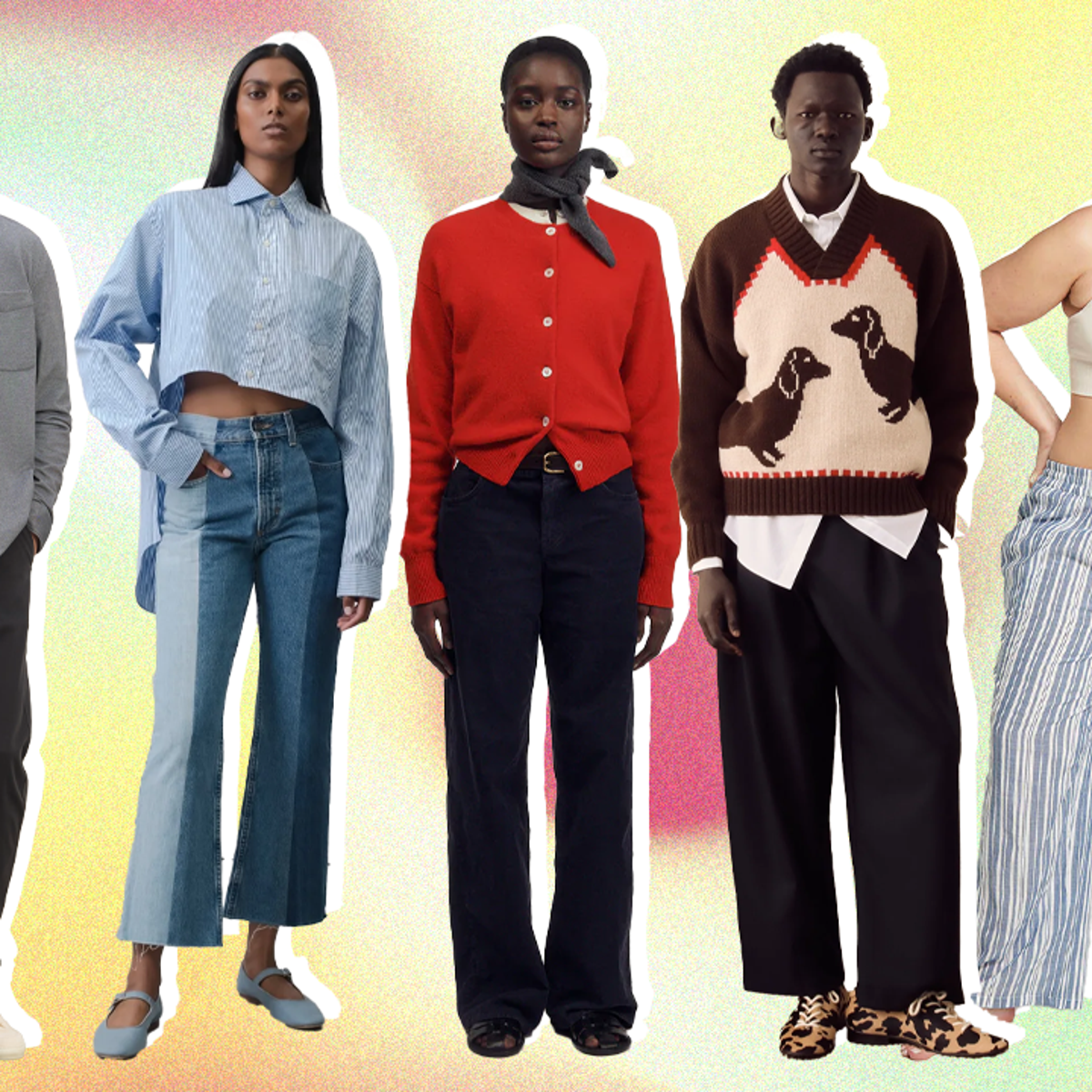The Significance of Lasting Garments: Exactly How It Impacts the Setting and Your Wardrobe
Lasting clothing is significantly recognized for its vital duty in minimizing the ecological effect of the quick garment industry. By concentrating on green products and honest manufacturing approaches, it addresses pressing eco-friendly problems. This change not just benefits the world but additionally affects consumer selections, bring about a much more thoughtful strategy to wardrobe management. Understanding these characteristics increases vital inquiries regarding fashion's future and individual obligation fit it.
The Ecological Impact of Quick Fashion

Advantages of Lasting Products
Lasting products offer significant advantages, particularly through eco-friendly fabric choices that decrease environmental damage. These products also show durability and long life, decreasing the need for constant substitutes. Because of this, they add to a more sustainable apparel industry and promote responsible customer habits.
Eco-Friendly Material Choices
While the style sector has long been connected with fast patterns and environmental injury, the rise of environmentally friendly textile choices presents a transformative possibility. Lasting materials such as natural cotton, hemp, and Tencel have gotten popularity because of their reduced eco-friendly impact. These textiles are usually produced without hazardous pesticides and need less water, reducing their carbon impact - Branded Clothing. In addition, several environmentally friendly materials are naturally degradable, adding to a circular economic situation by minimizing waste. Selecting lasting materials not just supports environmentally accountable methods yet likewise advertises healthier environments. As customers become a lot more knowledgeable about their purchasing power, the demand for environment-friendly textiles encourages brand names to innovate and adopt even more sustainable manufacturing approaches, eventually benefiting the planet and future generations
Durability and Longevity Advantages
Several customers are increasingly identifying the sturdiness and durability benefits of lasting products in their clothes choices. Unlike traditional textiles, sustainable materials such as natural cotton, hemp, and recycled polyester are engineered to hold up against damage, causing garments that last longer. This decreased regularity of replacement not just saves customers cash gradually yet additionally reduces waste produced by quick fashion. Additionally, lasting apparel frequently uses eco-friendly production methods that improve fabric toughness, adding to a reduction in the overall carbon footprint. By investing in resilient apparel, customers can cultivate a more sustainable closet while taking pleasure in high-grade pieces that maintain their visual and performance in time. Sturdiness and longevity stand as crucial benefits of picking sustainable products.
Decreasing Waste Via Sustainable Practices
Reducing waste in the garment industry can be achieved through ingenious techniques such as upcycling and repurposing products. In addition, adopting minimalist wardrobe strategies urges customers to focus on top quality over quantity, ultimately decreasing clothes intake. With each other, these strategies contribute substantially to a more sustainable garments design.
Upcycling and Repurposing Products
Upcycling and repurposing products have actually become innovative techniques in the fashion business, transforming discarded textiles into beneficial new products. This method not only decreases waste however additionally motivates creative thinking and originality in garments design. By taking old garments and products, developers can develop special pieces that show individual style while lowering the need for new resources. Furthermore, upcycling commonly needs less energy and water contrasted to traditional manufacturing processes, substantially decreasing the ecological impact of style. As customers come to be a lot more knowledgeable about sustainability, the appeal of upcycled clothing continues to rise, advertising a circular economic climate. Eventually, these practices add to an extra sustainable future, where fashion focuses on environmental health and wellness over rapid production and intake.

Minimal Wardrobe Strategies
As individuals significantly look for to reduce their environmental influence, adopting minimal wardrobe strategies has acquired grip as an efficient strategy to sustainable fashion. These strategies emphasize quality over quantity, motivating customers to curate a smaller sized collection of functional, long lasting garments. By focusing on classic items that can be combined and matched, people can decrease the regularity of purchases and inevitably decrease waste.Additionally, minimalism advertises conscious intake, prompting buyers to assess the honest and environmental ramifications of their selections. This technique not just cultivates a much more sustainable way of life however likewise streamlines everyday decision-making relating to clothes. As individuals welcome minimalist principles, they add to a style society that values sustainability and responsible consumerism, eventually bring about a much more eco-conscious society.
The Role of Honest Labor in Sustainable Fashion
While several customers are progressively familiar with the ecological consequences of their clothes options, the importance of ethical labor techniques in lasting fashion can not be forgotten. Honest labor includes fair salaries, risk-free working conditions, and regard for employees' civil liberties, developing the backbone of accountable style production. Brands that prioritize ethical labor not just boost communities but additionally set a requirement for liability in the industry.Moreover, the integration of ethical methods cultivates transparency, enabling customers to make informed choices concerning their purchases. This technique contrasts sharply with rapid fashion's unscrupulous labor models, which often focus on earnings over individuals. By supporting business dedicated to ethical labor, customers add to a system that values human self-respect alongside environmental sustainability. Consequently, honest labor is not just an add-on; it is necessary to the broader objective of lasting fashion, making sure that the pursuit for eco-friendliness does not come with the expense of civils rights.
The Impact of Lasting Clothes on Carbon Emissions
Lasting apparel has the potential to substantially minimize carbon browse around this web-site exhausts connected with the apparel industry. Conventional garment production adds significantly to greenhouse gas discharges, mostly as a result of energy-intensive production procedures and making use of non-renewable sources. On the other hand, lasting style concentrates on eco-friendly a knockout post materials, such as natural cotton or recycled fibers, which typically call for much less power to produce.Moreover, sustainable brands have a tendency to embrace much more efficient production practices, reducing waste and reducing general exhausts. By prioritizing durability and timeless design, sustainable garments urges consumers to get less often, more reducing the carbon footprint related to overconsumption.Additionally, numerous sustainable brand names are devoted to transparency in their supply chains, enabling customers to make educated choices that align with their values. Eventually, moving towards lasting clothing can lead to a considerable decrease in carbon exhausts, adding to a much healthier planet and an extra sustainable future for the apparel industry.
Supporting Regional Economic Situations With Lasting Choices
The change toward lasting clothing not just addresses environmental concerns but additionally substantially advantages local economic situations. By selecting lasting fashion, customers frequently sustain tiny companies and regional artisans, enhancing neighborhood strength. These enterprises generally run on a smaller scale, prioritizing craftsmanship and moral practices over mass production.Investing in locally made sustainable garments promotes task production and boosts financial development within neighborhoods. As customers become much more knowledgeable about the ecological effect of their purchases, they progressively look for items that reflect their values. This need encourages regional manufacturers to adopt sustainable practices, adding to a circular economy.Moreover, sustaining neighborhood businesses reduces transport discharges, aligning with eco-conscious customer actions. The interconnectedness of sustainable clothing and neighborhood economic climates emphasizes the important role that private selections play in advertising both economic and ecological health. By promoting these neighborhood links, neighborhoods can grow while additionally functioning in the direction of a much more sustainable future.
Changing Your Storage Room: Tips for a Sustainable Wardrobe
As individuals seek to decrease their environmental impact, transforming a storage room into a lasting closet comes to be a crucial step. One efficient approach is to review existing apparel, keeping only things that are used frequently and that straighten with sustainability objectives. Focusing on high quality over amount is important; buying durable pieces from environment-friendly brands can significantly lower waste.Additionally, integrating used things can revive a wardrobe while minimizing environmental damage. Organizing apparel swaps with good friends or giving away extra products can even more promote sustainability.When buying, people need to seek products that are organic, recycled, or eco-friendly, and prevent quick fashion retailers - Branded Clothing. Finally, practicing conscious usage by attentively taking into consideration each purchase can add to an extra sustainable lifestyle. By carrying out these suggestions, one can produce a closet that reflects individual style while sustaining environmental stewardship
Often Asked Questions
Just How Can I Recognize Sustainable Garments Brands?
To determine sustainable garments brands, one ought to investigate products utilized, look browse around this site for accreditations like Fair Trade, and check out the brand name's transparency about their production processes, labor practices, and environmental impact, ensuring honest and eco-friendly techniques are prioritized.
What Are the Costs Connected With Lasting Style?
The expenses related to sustainable fashion can vary considerably. Greater manufacturing expenses, moral sourcing, and eco-friendly materials commonly bring about boosted market prices, which might prevent some customers while interesting environmentally conscious customers.
Can Sustainable Clothing Be Stylish and Trendy?
Sustainable clothes can undoubtedly be stylish and trendy. Designers progressively prioritize ingenious products and moral production techniques, showing that style and sustainability can exist together. Customers now have varied alternatives that blend aesthetic appeals with environmental consciousness.
How Does Washing Clothing Affect Their Sustainability?
Cleaning clothes considerably impacts sustainability by consuming water and energy, adding to pollution, and creating microplastic release. Constant washing can break down textiles, shortening their life expectancy and enhancing the requirement for substitutes, eventually intensifying ecological concerns.
What Is the Lifespan of Sustainable Clothes Compared to Quick Style?
The lifespan of sustainable garments normally exceeds that of fast fashion products, usually long lasting numerous years due to quality products and workmanship. On the other hand, fast style garments may weaken swiftly, demanding even more frequent substitutes. Sustainable clothing is increasingly recognized for its crucial duty in reducing the ecological impact of the fast fashion market. While lots of customers are increasingly conscious of the environmental repercussions of their clothes selections, the value of honest labor methods in sustainable fashion can not be neglected. Branded Clothing. Sustainable clothing has the possible to greatly reduce carbon emissions linked with the fashion market. In comparison, sustainable style focuses on green materials, such as organic cotton or recycled fibers, which often call for much less power to produce.Moreover, lasting brand names have a tendency to embrace extra reliable production methods, lessening waste and lowering overall exhausts. By focusing on toughness and ageless layout, lasting clothing urges customers to buy less often, more lowering the carbon impact linked with overconsumption.Additionally, lots of sustainable brand names are devoted to openness in their supply chains, allowing consumers to make enlightened selections that straighten with their worths